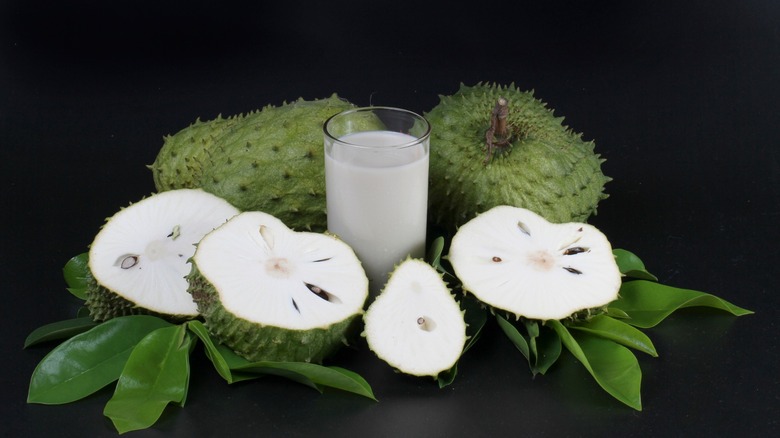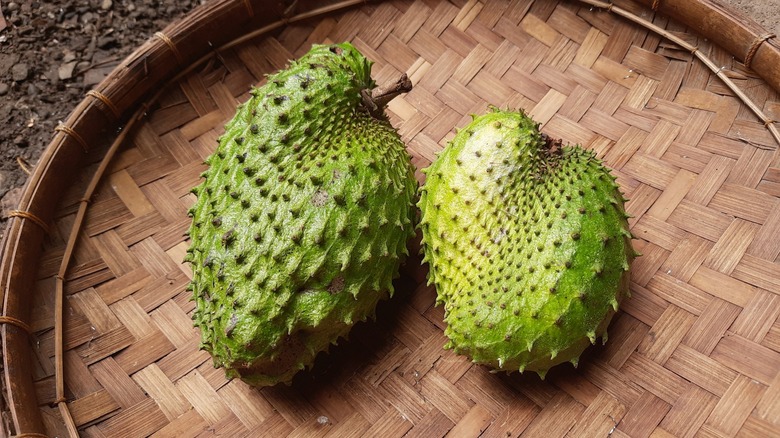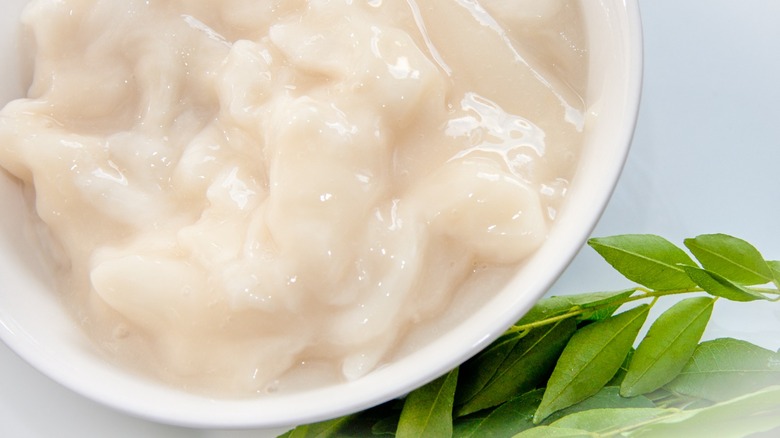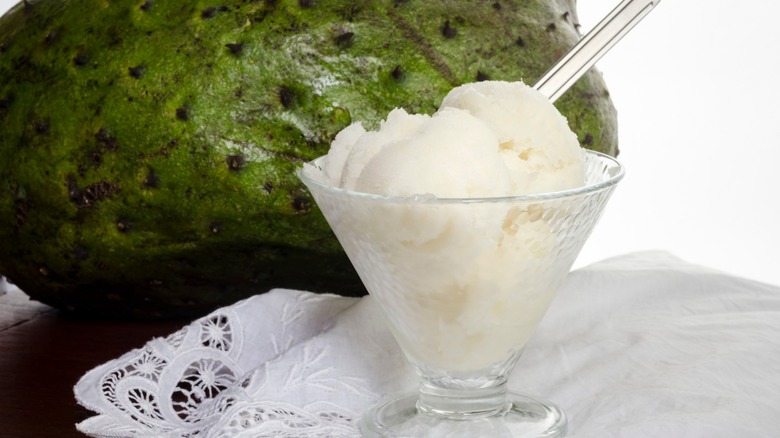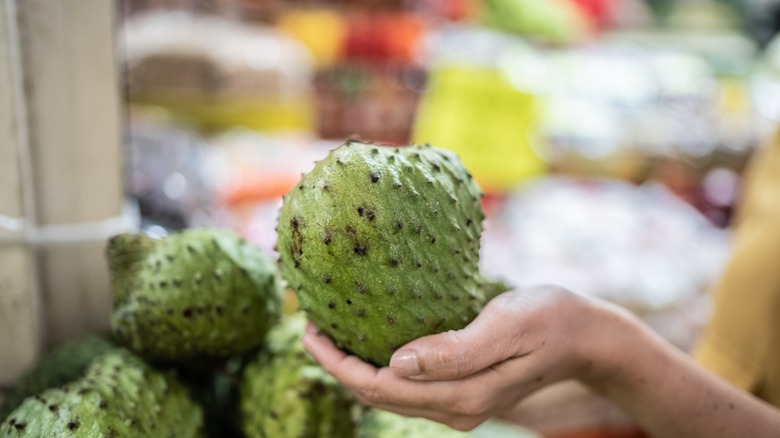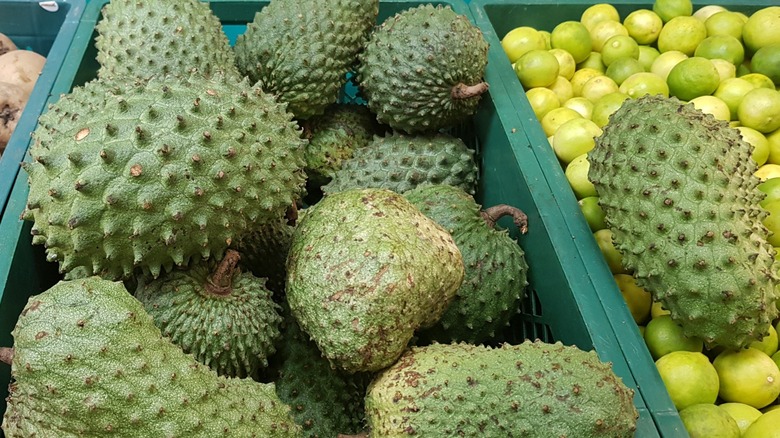Soursop Fruit Is Difficult To Eat But Packs Rewarding Flavor
Soursop (Annona muricata) may not be lying amongst the usual fruits in the supermarket produce aisle, but take a trip to Central or South America or the Caribbean, and you'll quickly discover its popularity. There's a good reason this fruit is popular; soursop is packed with a sweet, tangy flavor that elevates a tropical smoothie to refreshing nirvana. Also called guanábana or graviola, the fruit also offers a unique experience when enjoyed right out of its shell, although it's a bit more difficult to eat than the average fruit.
Soursop's global influence has spread to Southeast Asia and North Africa, where it's widely grown and consumed. The fruit is perhaps most well known for its use as a possible natural anticancer agent. There is, of course, more than a fair amount of controversy and debate about this health claim, and there's no exact evidence of soursop as a cure for cancer. Don't let that dissuade you from eating it, though; soursop is still a highly nutritious fruit that's packed with vitamins and antioxidants, according to Healthline.
What is soursop?
Soursop is identifiable by its distinct green hue and bumpy outer casing, with a shape that somewhat resembles a pear. Cutting open the fruit reveals a milky white interior that hints at its creamy consistency, although you have first to remove the big black seeds that line the inside. You can attempt to cut soursop into slices, but you'll quickly find that it's much too soft and spongy to cleanly dice up like you would if you were eating, say, watermelon or pineapple. Instead, it's easier and more fun to scoop lumps of it out with a spoon.
Part of the reason why it's rarer to find soursop in the United States — and other places with temperate climates — is that it's extremely difficult to grow and maintain outside of the tropics. The plant can withstand the dry seasons that occur during winter in Central and South America, but not actual winter cold. As part of the Annonaceae family — which also includes custard-apples and cherimoya — soursops and their kin are highly concentrated in tropical regions. Only a few species of plants in the Annonaceae family, such as pawpaws, are native to temperate zones.
What does soursop taste like?
It's common to hear the flavor of soursop described as a cross between pineapple and strawberry but with a citrusy kick. It's a tropical fruit, so it may also remind you of other tropical fruits like mango, passion fruit, or guava. The broadest way to describe the taste is a harmonious balance of sweet and sour, although, like other fruits, it will taste bitter if consumed when not properly ripened. You can tell when soursop is ripe when it's a lighter green and if it feels soft when poked.
The most unique part of soursop, however, is its texture, which has a soft, creamy mouthfeel more akin to bananas than any citrus fruit. This is because of the stringy fibers that make up the inside of the fruit, although this is by no means that soursop is lacking in juice. On the contrary, the succulent guanábana is highly prized for its penchant to liven up smoothies, jellies, and ice cream.
How to use soursops
Blending soursop up into a beverage or dessert is a common way to experience its refreshing taste without going through the potential mess of scooping its innards out. Champola de guanábana is a simple but highly rewarding blend of soursop and water, usually with a touch of sugar added to sweeten things up. Soursop also mixes well in concoctions like the horchata-like soursop punch, in which sweet ingredients like cinnamon, nutmeg, and vanilla are combined with milk to complement the natural creaminess of the fruit with dairy.
It comes as no surprise, then, that soursop also makes for a nice ice cream flavor, a common menu item in Latin American and Caribbean dessert shops. Malaysia and Indonesia make a shaved ice dish called ais kacang that can incorporate soursop into its flavor profile, as well. Southeast Asian cuisine has also grown accustomed to turning the fruit into a jelly called dodol. Additionally, soursop jam is commonly found across locales that grow the fruit.
Nutritional information about soursop
Soursop has a reputation for its reported anticancer properties, but take these claims with a grain of salt. According to studies published in 2016 and 2014, previous lab studies have shown that soursop extract has stopped the growth of breast cancer and leukemia cells inside a test tube, respectively. Additionally, another 2016 study showed that soursop could inhibit the growth of prostate cancer cells in mice. However, no clinical trials have been conducted, so soursop's effect on humans diagnosed with cancer is still unknown.
That luckily doesn't mean that soursop is bad for you, though. It's packed with fiber, Vitamin C, and the B vitamins thiamine and riboflavin, reports the U.S. Department of Agriculture. Antioxidants within the fruit can help boost immunity and prevent cell damage, possibly making soursop an effective anti-inflammatory, explains Harvard. However, further research is needed on this aspect of soursop.
The health benefits of soursop aren't exactly a new discovery. The fruit has been used in Africa to treat skin diseases and in South America to treat diarrhea and parasitic infections, per a 2022 study. On the other hand, a 2006 study linked soursop's annonacin to Parkinson's disease. Caribbean populations that consume the fruit seem to have higher rates of the disease, but this theory is still inconclusive.
Where to buy soursops
Soursop pulp can be found in your local Latin American or Southeast Asian supermarket. Goya is the most common brand that carries guanábana pulp, as well as guanábana nectar, the latter of which contains added sugar. Occasionally, you can luck out and find guanábana ice cream made by the brand Frutero at Whole Foods.
Whole soursop fruit is significantly harder to find in the U.S., though contrary to a strange internet rumor, it's not illegal to import and sell. Rather, it seems to be more of the fruit's inability to withstand subtropical temperatures during transport.
You might be able to spot it at an international grocery, and you can order it online at Goldbelly, where it's grown by specialty farmers in Miami, Florida — if you're willing to pay the extra price. Just keep your eyes peeled the next time you visit your local Asian or Latin supermarket; you might just spot a spiky green soursop that's calling your name.

